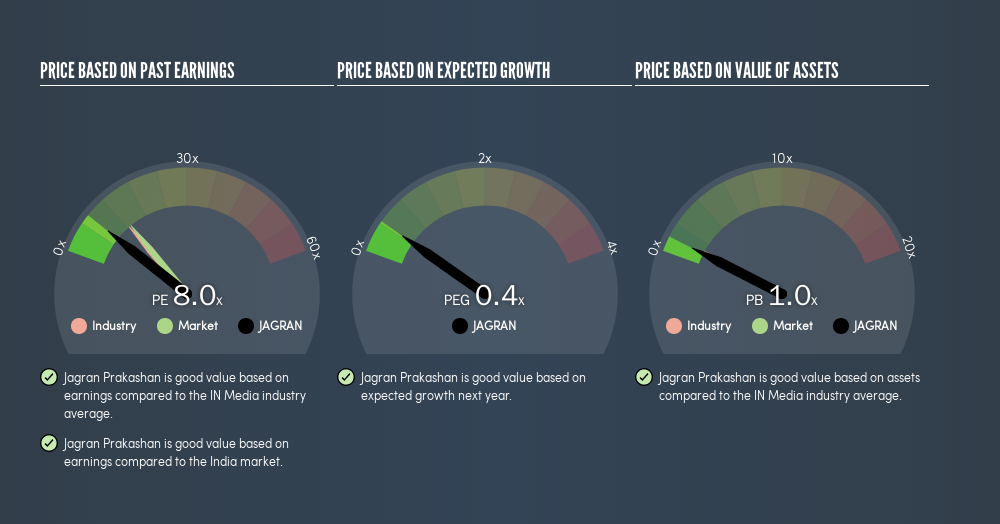What Is Jagran Prakashan's (NSE:JAGRAN) P/E Ratio After Its Share Price Tanked?
Unfortunately for some shareholders, the Jagran Prakashan (NSE:JAGRAN) share price has dived 30% in the last thirty days. Indeed the recent decline has arguably caused some bitterness for shareholders who have held through the 48% drop over twelve months.
All else being equal, a share price drop should make a stock more attractive to potential investors. While the market sentiment towards a stock is very changeable, in the long run, the share price will tend to move in the same direction as earnings per share. So, on certain occasions, long term focussed investors try to take advantage of pessimistic expectations to buy shares at a better price. One way to gauge market expectations of a stock is to look at its Price to Earnings Ratio (PE Ratio). A high P/E implies that investors have high expectations of what a company can achieve compared to a company with a low P/E ratio.
Check out our latest analysis for Jagran Prakashan
How Does Jagran Prakashan's P/E Ratio Compare To Its Peers?
Jagran Prakashan's P/E of 7.97 indicates relatively low sentiment towards the stock. We can see in the image below that the average P/E (12.8) for companies in the media industry is higher than Jagran Prakashan's P/E.

Its relatively low P/E ratio indicates that Jagran Prakashan shareholders think it will struggle to do as well as other companies in its industry classification.
How Growth Rates Impact P/E Ratios
If earnings fall then in the future the 'E' will be lower. That means even if the current P/E is low, it will increase over time if the share price stays flat. So while a stock may look cheap based on past earnings, it could be expensive based on future earnings.
Jagran Prakashan saw earnings per share decrease by 12% last year. But EPS is up 2.5% over the last 5 years. And EPS is down 9.3% a year, over the last 3 years. This growth rate might warrant a low P/E ratio.
Remember: P/E Ratios Don't Consider The Balance Sheet
One drawback of using a P/E ratio is that it considers market capitalization, but not the balance sheet. So it won't reflect the advantage of cash, or disadvantage of debt. Hypothetically, a company could reduce its future P/E ratio by spending its cash (or taking on debt) to achieve higher earnings.
While growth expenditure doesn't always pay off, the point is that it is a good option to have; but one that the P/E ratio ignores.
How Does Jagran Prakashan's Debt Impact Its P/E Ratio?
Since Jagran Prakashan holds net cash of ₹176m, it can spend on growth, justifying a higher P/E ratio than otherwise.
The Verdict On Jagran Prakashan's P/E Ratio
Jagran Prakashan trades on a P/E ratio of 8, which is below the IN market average of 13.3. Falling earnings per share are likely to be keeping potential buyers away, but the net cash position means the company has time to improve: if so, the low P/E could be an opportunity. What can be absolutely certain is that the market has become more pessimistic about Jagran Prakashan over the last month, with the P/E ratio falling from 11.4 back then to 8 today. For those who prefer invest in growth, this stock apparently offers limited promise, but the deep value investors may find the pessimism around this stock enticing.
Investors have an opportunity when market expectations about a stock are wrong. If it is underestimating a company, investors can make money by buying and holding the shares until the market corrects itself. So this free report on the analyst consensus forecasts could help you make a master move on this stock.
Of course, you might find a fantastic investment by looking at a few good candidates. So take a peek at this free list of companies with modest (or no) debt, trading on a P/E below 20.
We aim to bring you long-term focused research analysis driven by fundamental data. Note that our analysis may not factor in the latest price-sensitive company announcements or qualitative material.
If you spot an error that warrants correction, please contact the editor at editorial-team@simplywallst.com. This article by Simply Wall St is general in nature. It does not constitute a recommendation to buy or sell any stock, and does not take account of your objectives, or your financial situation. Simply Wall St has no position in the stocks mentioned. Thank you for reading.
About NSEI:JAGRAN
Jagran Prakashan
Jagran Prakashan Limited prints and publishes newspapers and magazines in India.
Undervalued with excellent balance sheet and pays a dividend.
Similar Companies
Market Insights
Community Narratives



